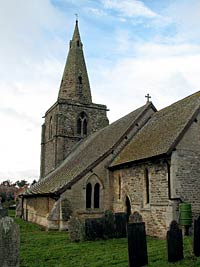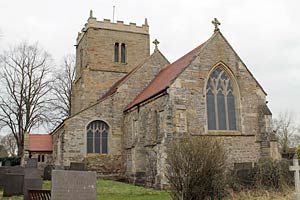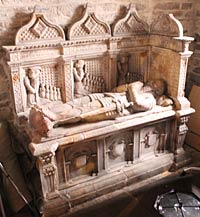< Previous | Contents | Next >
The Three Old Bells
 Scarrington church in 2005.
Scarrington church in 2005.© Copyright Bob Danylec and licensed for reuse under this Creative Commons Licence
SCARRINGTON. Trim houses and wayside lawns help to make this quiet village in green meadows. There is a fine stone dovecot in a farmyard, and the small dim church has a few things old and interesting.
Its striking feature is the 14th century tower with a spire lighted by two tiers of dormer windows. Its lofty west doorway is adorned with ballflowers and a string of four-leaved flowers. Still ringing in the tower are three bells believed to have been ringing before the Reformation.
Between the nave and aisle is a 14th century arcade of three wide arches on pillars with stone seats. A century older is the priest's doorway. There are three old tie-beams, a Jacobean coffin stool, and a small font made in 1662.
The Man Who Took Away the Bauble
SCREVETON. An old-world village untroubled by the bustle of the highways is this place of a few homes, though the Fosse Way where the Roman legions marched from Leicester to Newark is less than a mile away. It gave the county its famous historian in Robert Thoroton, and has something to remind us of another family who made a stir in their day, the Whalleys.
Not far from the church (but belonging to Car Colston) is Brunsell Hall, part of the fine 17th century house where lived Dr Brunsell, rector of Screveton during the Commonwealth. The timbered house near the rectory has remains of 400 years ago, and the rectory itself is partly on the site of Kirketon Hall, the old home of the Whalleys.
One of the Whalleys was physician to Henry the Seventh. Another was Richard, who won the admiration of Henry the Eighth by his grace and skill in military exercises; his remarkable monument is in Screveton Church. He also became notorious for the part he played in the destruction of the monasteries; and for his services in this business he received Welbeck Abbey, though he had to part with it to raise money for the fines imposed on him for sharing in the intrigues of Protector Somerset.
One of his descendants was the Edward Whalley whose mother was an aunt of Oliver Cromwell, and who was himself the only Roundhead in the Whalley family. It was he who carried away the Bauble when Cousin Oliver dissolved the Long Parliament, and he had charge of the King after his capture by Cornet Joyce at Holdenby House. After the Restoration he was stripped of his estates and he fled to America and died in exile after 14 years of hunted life.

Screveton church in 2013.
© Copyright J.Hannan-Briggs and licensed for reuse under this Creative Commons Licence
Almost hidden from the road and reached by a long row of limes is the pretty church in a lovely churchyard. Much of it is 13th century, the time of the nave arcades.; the sturdy 15th century tower was altered in the time of Elizabeth. Three relics of an earlier church are a loose fragment of Saxon knotwork (once part of a tomb), part of a Norman coffin stone engraved with a cross, and an exceptionally beautiful Norman font with interlaced arcading. The south aisle has a beautiful piscina, there are two Jacobean coffin stools, and a splendid 15th century chest nearly seven feet long is encircled by a score of iron bands. An old miserere in the chancel, carved to represent Winter, shows a man in a loose wrap warming himself at a fire; a later one has St Wilfrid. The arms of Charles the Second, carved in oak, are under the tower.

The Whalley monument in Screveton church in 2013.
© Copyright J.Hannan-Briggs and licensed for reuse under this Creative Commons Licence
One of the finest monuments in the county is the magnificent tomb of Richard Whalley, which has been moved from the chancel to the tower. He has a long beard, and lies in armour with his head and his feet resting on whales. In the panels of its elaborate screen are the kneeling figures of his three wives, and small figures of their 25 children kneel behind their respective mothers. A quaint inscription tells of their father's virtues.
